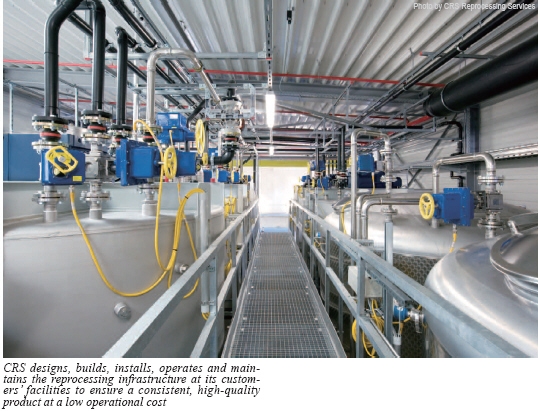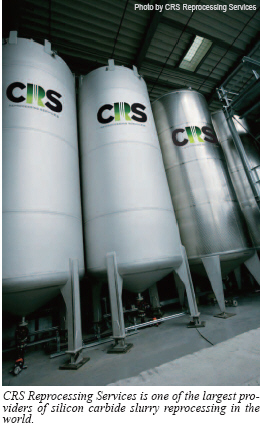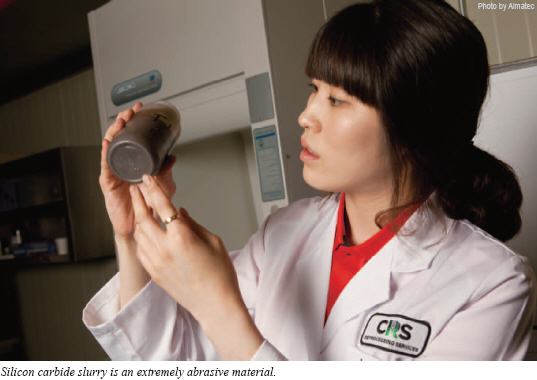By Sergio Avila
.jpg)
Headquartered in Louisville, Kentucky, the U.S.A., CRS Reprocessing Services is one of the largest providers of silicon carbide slurry reprocessing in the world, allowing more than 150,000 MT of slurry to be recycled and reused annually. With customers in Germany, France, Spain, Korea, Japan, China and North America, CRS is responsible for recovering spent slurries for companies that serve the Photovoltaic (PV) and semiconductor industry, including three of the top solar wafer manufacturers in the world.
The CRS Process
Developed over years of refinements dating back to the introduction of slurry reprocessing, CRS’s process for recovering spent slurries is a proprietary method incorporating diluents and mechanical processes devoid of chemicals to facilitate the separation of recoverable grit and carrier. As part of this process, CRS offers Optimized Reprocessing Management (ORM), which involves designing, building, installing, operating and maintaining the reprocessing infrastructure at its customers’ facilities to ensure a consistent, high-quality product at a low operational cost.
To help guarantee that slurry reprocessing is running as efficiently and effectively as possible, CRS installs customized equipment and provides operating technicians and engineering support within a customer’s infrastructure. When installing this customized equipment, CRS only selects the most innovative technology available that has been proven to be ideal in slurry applications. This ensure CRS is optimizing its customer’s wafering operations in the most efficient manner possible, with a special emphasis placed on slurry quality control and cost reduction.
The importance of such efficiency measures cannot be overestimated when it comes to reprocessing slurry. Slurry is often second in cost only to the raw material silicon, so any cost savings can impact the bottom line in a substantial way. Optimizing slurry reprocessing can have dramatic, lasting effects on wafer product costs and overall quality. Therefore, it is critical that CRS uses components in its reprocessing systems that will minimize downtime and improve operations for its customers.
“Our business model is to provide slurry reprocessing onsite for the customer, and we are obligated to provide 24-hour-7-day-a-week service,” says Scott Radeker, Vice President of Operations for CRS. “So when we go to design a system at a customer’s facility, we have to consider component uptime and identify the possible weak points to the process. We need to ensure our customer always has slurry available to them. When we have equipment failures or outages, we put our customers at risk of being down, which would be a huge cost to them, and we could potentially be obligated to help cover that cost.”

Pumping Slurry Can Be a Problem
 Playing a vital role in slurry reprocessing, and part of the customized equipment that CRS employs, are heavy-duty industrial pumps. These pumps transport the silicon carbide slurry through the slurry recovery process. This enables CRS to separate the reusable carrier fluid (polyethylene glycol or light mineral oil) and the silicon grit, from the diluting substance, which is used to facilitate the separation of the recoverable grit and carrier fluid. This pumping equipment must be made from strong materials that are able to resist the etching or galling caused by these abrasive slurries. It is critical that the pumps be extremely reliable despite these demanding conditions. Playing a vital role in slurry reprocessing, and part of the customized equipment that CRS employs, are heavy-duty industrial pumps. These pumps transport the silicon carbide slurry through the slurry recovery process. This enables CRS to separate the reusable carrier fluid (polyethylene glycol or light mineral oil) and the silicon grit, from the diluting substance, which is used to facilitate the separation of the recoverable grit and carrier fluid. This pumping equipment must be made from strong materials that are able to resist the etching or galling caused by these abrasive slurries. It is critical that the pumps be extremely reliable despite these demanding conditions.
“When you are trying to transport slurry from point A to point B, one of the things that can be challenging is selecting the correct pump for the application because they have a tendency to wear very quickly,” explains Radeker. “One of the biggest costs for us─and for our customers─is interrupted supply. So, from our perspective, a pump needs to be reliable and able to feed the process consistently. It has to have a long mean time between failure, and an extremely low rate of breakage.”
Since becoming involved with slurry reprocessing, CRS has utilized a number of different types of pumps for its slurry applications, but found that most of them were not suitable for handling slurry. For instance, many slurry processes involve both wet and dry applications, and few pumps are well suited for both. CRS also found that pumps made with metal parts frequently corrode quickly due to the abrasive slurry, and the sealing oil’s lubricating properties degrade under the sharp silicon particles. Another problem experienced by some pumps is pulsation during liquid transfer, which can interrupt or clog the flow of material, resulting in pressure spikes and, ultimately, leakage and breakdowns.
“When we first started getting involved with slurry, we had pumps that would last for a matter of days or even hours,” says Radeker. “We were using a brand of diaphragm pumps that were just not holding up. In terms of reliability and total cost of ownership, we needed to go in a different direction with our pumping technology.”
Understanding this better than anyone was Andreas Franke. Before becoming the Global Project Engineering Manager for CRS, the position he holds today, Franke worked as a field technician in one of CRS’s facilities located in Germany. While in the field, one of his responsibilities was to maintain the pumping equipment, and it was pretty obvious to him that the pumping equipment being utilized by CRS was becoming more of a problem than a solution. Over the years, he had definitely seen his fair share of costly pump breakdowns and failures.
“When I was still a field technician, all of our slurry regulation systems were designed for use with oil-based slurry, so we were able to use diaphragm pumps manufactured from aluminum,” says Franke. “But when we started using a slurry with PEG as carrier, we learned pretty quickly that aluminum pumps were not resistant enough against this type of slurry. We had all sorts of pump failures. The main reasons were either broken diaphragms, or the bolt check valves wore out too quickly. We knew we needed a new pumping solution. This was about the time we discovered Almatec.”
PE Pumps to the Rescue
In the summer of 2005, Almatec®, a German-based manufacturer of Air-Operated Double Diaphragm (AODD) pumps, approached CRS with an idea. They provided an alternative pump, with features and materials of construction more ideally suited to slurry applications. Realizing it was in need of a pump that would help keep its slurry production costs low, CRS decided to collaborate with Almatec on this new project.
“When Almatec came in, I shared the many issues we were having with our aluminum diaphragm pumps,” explains Franke. “So Almatec conducted some tests comparing different types of materials to find out which materials held up best against abrasive liquids. They compared aluminum, Polypropylene (PP) and Polyethylene (PE). After the results were in, it became pretty clear that PE was going to be a much better solution.”
As a result of these tests, and after discussing additional features with CRS, Almatec began manufacturing modified plastic air-operated diaphragm pumps that featured a solid body design constructed with PE material, which has an abrasion resistance 7 times higher than that of polypropylene and 1.6 times higher than steel. By utilizing a dense solid body construction, Almatec was able to create a harder, more reliable pump that has the capability to handle the demands of working with slurry, all while lengthening the pump’s life cycle and eliminating many maintenance concerns. This solid body construction also provides a wide range of advantages to CRS, including increased pump safety due to an innovative ring-tightening structure; increased product capacity; decreased air consumption; reduced noise level; optimized flow pattern; and a screwed-on or flanged pulsation damper.
“Almatec gave us a few test pumps and we installed them in one of our reprocessing systems in Germany and they lasted for over 3 months,” explains Franke. “At the time, 3 months was extremely impressive to us. It became clear that these pumps were far superior to the pumps we were previously using; mostly because these pumps were machined from solid PE material. They lasted so much longer than our previous aluminum pumps. In fact, the pumps worked so well, we asked Almatec to provide us with a 3˝ model of the pump. We needed a bigger pump for our long slurry loops. Almatec provided one, we tested it, and it worked great.”
In addition to solid body construction, Almatec designed these pumps with diaphragms that have larger overall diameters combined with shorter than normal stroke lengths, which facilitates low flex loads and equates to a longer diaphragm life. This results in lower operational costs and fewer pump breakdowns.
“Prior to switching to Almatec pumps, we were spending quite a bit on pump maintenance costs, and our field technicians were spending 60 to 70% of their time servicing those pumps,” says Franke. “With Almatec, we cut our pump maintenance costs by roughly 80%. Since these Almatec pumps feature a long lifetime and easy maintenance, it really cuts down on our operating costs.”

After the success CRS experienced with Almatec pumps in its German facilities, CRS contacted Brian Gibson, a Territory Manger with Werner-Todd Pump Company based in Louisville, KY, the U.S.A. Gibson began working with CRS management to educate them on the Almatec product line, and eventually developed a great working relationship with them. With the help of Gibson, CRS was purchasing and installing Almatec pumps for every one of its current reprocessing systems, in addition to specifying Almatec pumps be used for any new systems.
“Brian has been very helpful to us,” explains Radeker. “When we have purchase orders or parts we need, he works with us very well to get them to where they need to go. He has also been very helpful in putting us in touch with support people in each country. Now, we can get service locally and we don’t have to ship pumps from Louisville to where they ultimately need to be installed.”
“From a customer and vendor perspective, Almatec was extremely willing to work with us and develop these pumps to the specifications we needed,” says Radeker. “They listened to our employees worldwide and learned what pump improvements were needed. We use perhaps 25 or 30 different vendors to build one of our systems. As far as Almatec is concerned, I can’t recall a time when we’ve had a supply issue that wasn’t resolved quickly. We get the parts and the pumps when we need them. Almatec pumps have definitely been worth it from a cost of ownership standpoint. We have adopted Almatec pumps on all of our systems ever since.”
Sergio Avila is the Almatec Product Specialist with Pump Solutions Group (PSG™), Downers Grove, IL, the U.S.A. Almatec (www.almatecsolar.com) is one of the world’s leading manufacturers of Air-Operated Double-Diaphragm (AODD) pumps.
For more information, please send your e-mails to pved@infothe.com.
ⓒ2011 www.interpv.net All rights reserved. |



